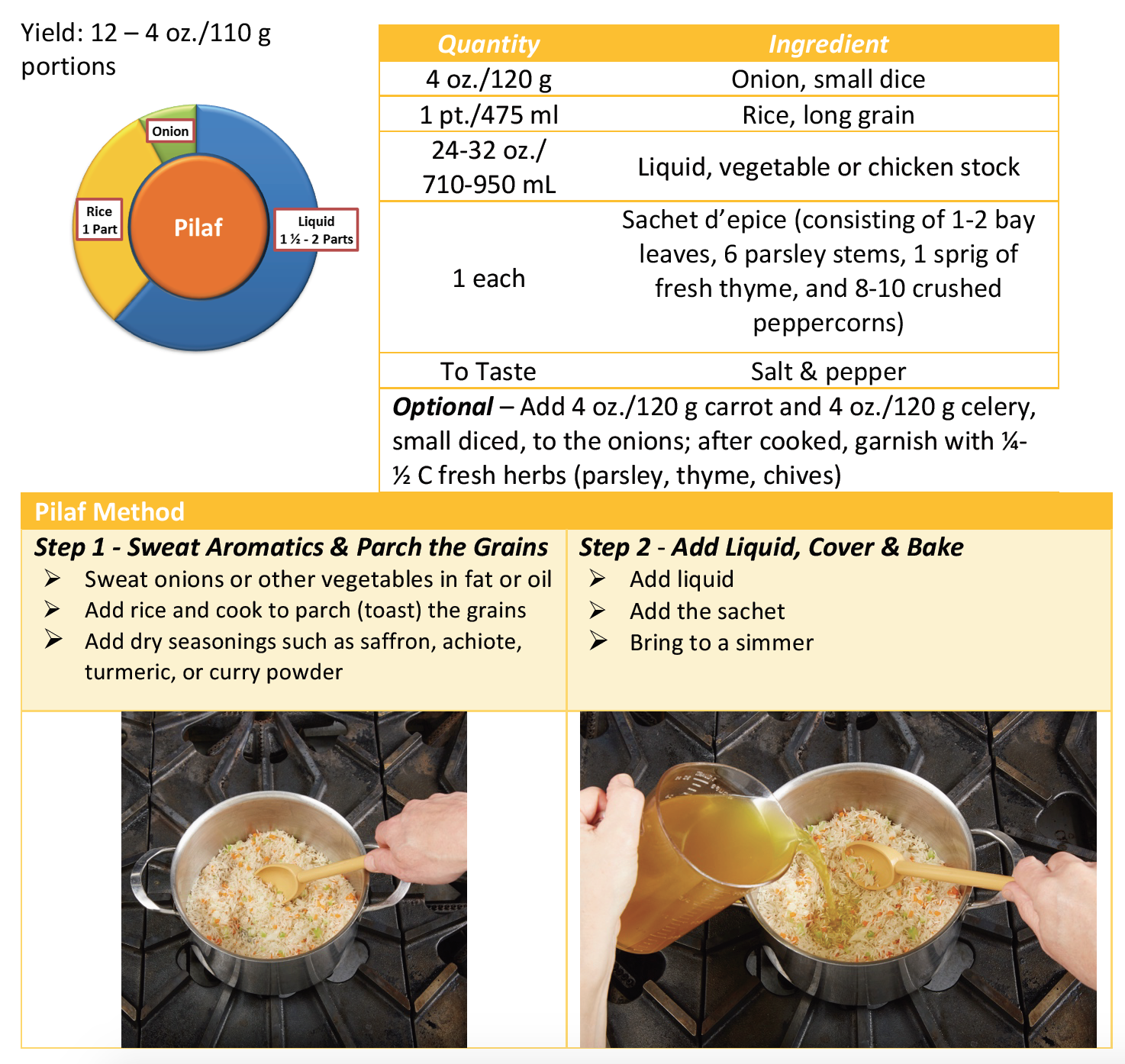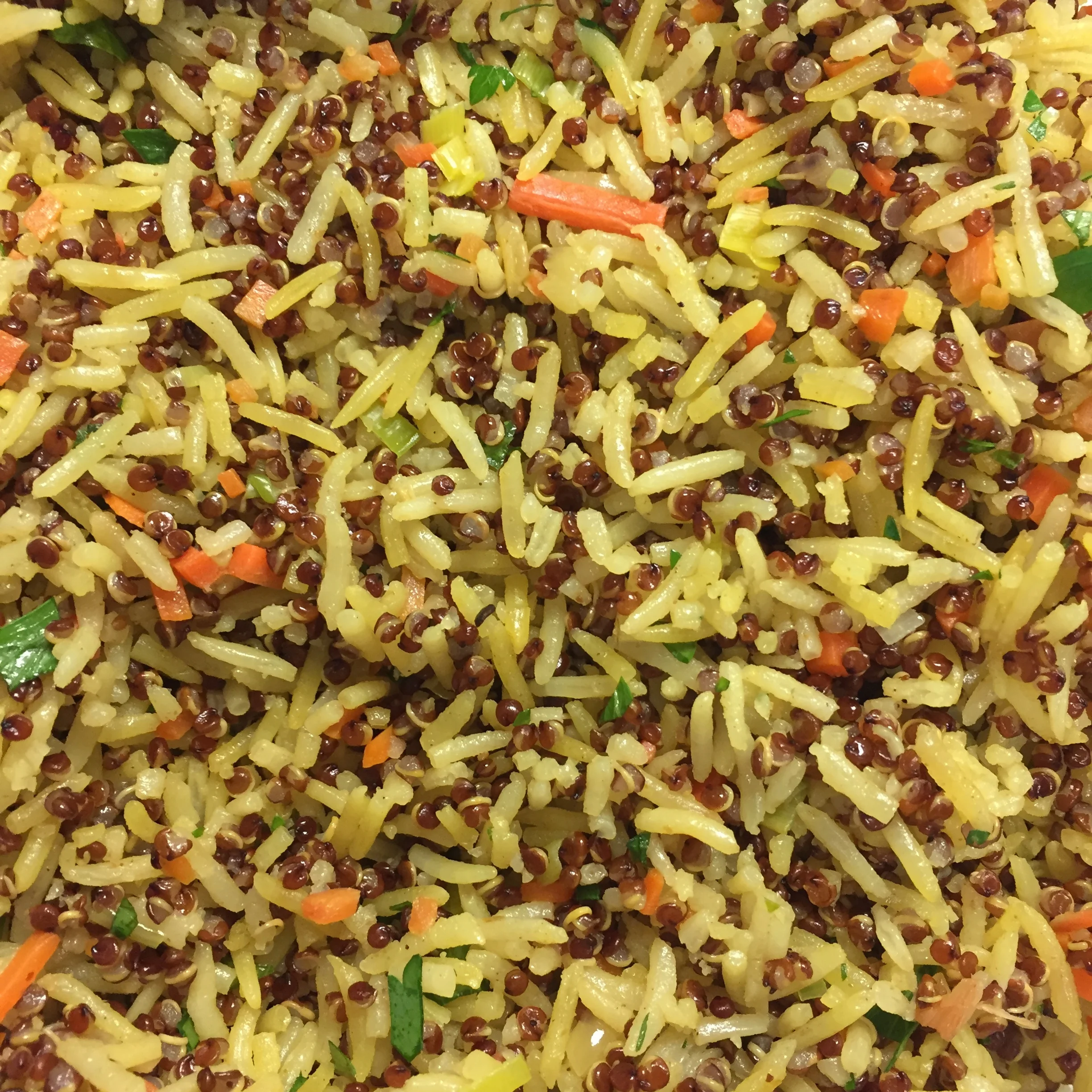Cooking Rice & Grains
Rice is the second most popular grain after corn and is used in soups, salads, entrees, side dishes, and desserts. Many classic rice dishes, like pilaf and risotto, can be adapted for other grains or pasta varieties, including barley, quinoa, and orzo. Rice and grains are low-cost items that provide profitable menu options when creatively combined with premium ingredients. Here are a few ways to prepare rice and other grains.
Basic Preparations
Boiled
Cooked using the same method as pasta, the boiling method suits any grain. Use a ratio of one gallon/ four liters of water to one pound/450 grams of grains.
Salt the water, bring it to a full boil, and add the rice.
Simmer gently and stir occasionally.
Cook until the grains are al dente and tender but have a firm texture.
Strain and rinse.
Use it for salads, soups, or as a prep stage for finishing later.
Steamed & Simmered
Steaming and simmering are two names for essentially the same process. The liquid is combined with the grains, covered, and gently brought to a simmer.
The grains may be rinsed or soaked and are sometimes blanched in several changes of water to remove bitterness or impurities.
Porridge, Polenta & Grits
Porridge
Porridge is prepared by boiling oats, rice, wheat, barley, or corn to create a thick meal served as a hot cereal or a side dish. Grains are rolled, steel-cut into groats, or ground, and simmered in liquid until the grains swell and thicken the mixture. Oatmeal, grits, and polenta are the most popular of these dishes.
The liquid, water, stock, or milk is usually brought to a simmer, and the grains are added.
Some preparations, like oatmeal, may include sugar, honey, maple syrup, dried fruits, or nuts.
For savory preparations, including grits and polenta onions, garlic or other aromatics may be added along with cheese, bacon, or eggs.
Pilaf
Pilaf, or pilau, is braised rice, or other grains, that begin by sweating aromatic vegetables, including onions, carrots, celery, and garlic, in fat. The rice is added to the fat and parched, or toasted, to develop color and flavor. The liquid and seasonings are added, and the dish is covered and cooked, either on the stovetop or in an oven. Long grain par-cooked white rice (Basmati and Carola) holds their shape the best in a pilaf.
Pilaf can be garnished with a variety of meats, cheeses, herbs, and spices. Fold in lemon zest, dried fruits, or toasted nuts, after the rice has cooked. Add fresh herbs at service time. Use this method for other grains, and create variations with additional vegetables, proteins, and liquids, including stocks and broths.
Variations
Grains
Mixed Grain Pilaf
Pilaf variations of pilaf can be made with a variety of grains (see grain charts for cooking ratios)
Try a medley of three types of grains such as white rice, wild rice, and quinoa
Aromatics
Vary the aromatics, for example substitute green onions or leeks for the onions, and add mushrooms and tomatoes
Use a matignon (instead of a mirepoix) of onions, celery, and carrots with ham or bacon; a Cuban sofrito of onions, garlic, and peppers; a Cajun trinity of green onions, celery, and green peppers; or an Italian battuto of pancetta, onions, celery, carrots, garlic, and red chili flakes
Proteins
Add bacon, salt pork, chicken, lamb or seafood
Add cooked legumes such as red lentils, or black beans as a garnish
Herbs and Spices
Add spice blends to create different ethnic flavors, for example curry powder or garam masala for an Indian pilaf, or achiote powder
Garnish with a variety of fresh herbs, or herb pastes such as a basil or kale pesto
Liquids
Use different stocks, for example chicken or vegetable
Add tomato juice or puree
Use coconut milk in a Jasmine rice pilaf
Risotto
A method of cooking short grain rice in Italy, risotto begins by sweating aromatics in fat, adding the rice, and then slowly adding the liquid one ladle at a time. The dish is finished with butter and cheese, which gives it a creamy and savory finish. Aborio, Vialonne Nano, and Carneroli are the best varieties for a risotto. Substitute other grains for the rice, including barley, brown rice, or orzo (some grains including barley and farro need par cooking). Start with aromatic vegetables of garlic and onions, and add mushrooms, celery, or carrots for variety. Deglaze the rice with white wine, before adding chicken or vegetable stock. Spices, including saffron, should be dissolved in the stock before adding. Garnish with sautéed mushrooms, diced tomatoes, or seafood such as shrimp, scallops, or mussels. Fresh herbs add a finishing touch.
The key to a good risotto is to gradually add the stock or other liquids, and gently stir, or “rearrange” the rice until the liquid evaporates. Avoid stirring too much, because even though short grain rice is hearty, it will still breakdown if over-mixed. Continue to add liquid one ladle at a time, until the desired consistency of the rice is attained. The rice should be cooked through, but still have a distinct firmness or “bite” to it.
Foodservice Prep
Par Cooked Risotto
For foodservice preparation of risotto, par cook the rice to prior to service until slightly underdone.
Cool the rice on a sheet pan.
Finish to order with additional stock, cheese, butter, and garnishes.
Risotto Variations
Grains
Prepare risotto variations with grains including farro, Thai black rice, or orzo (see grain charts for cooking ratios)
Try a medley of three types of grains such as aborio, farro, and quinoa; but cook separately because the grains will cook differently
Aromatics
Add aromatics for variety, for example substitute shallots or leeks for the onions, and add mushrooms
Use an Italian soffritto of onions, celery, and carrots, or battuto of pancetta, onions, celery, carrots, garlic, and red chili flakes
Try adding small-diced beets for a striking red color, diced root vegetables like celery root, or diced squash varieties like butternut or delicata
Proteins
Add savory ingredients like bacon, salt pork, chicken, lamb, or seafood
Add cooked legumes such as red lentils, or black beans as a garnish
Herbs and Spices
Add spice blends to create different flavor profiles, for example saffron, Cajun spices, or curry powder
Garnish with a variety of fresh herbs, like sage, or chives; or a basil pesto
Liquids
Use different stocks, for example chicken, or vegetable
Try a red wine for a more robust flavor and color
Other Braised Rice Dishes
Paella
A Spanish dish that originated in Valencia made with short grain rice, saffron, chorizo, seafood and chicken or rabbit. Paella is prepared in a special large flat pan called a paellerra. The two most popular short grain rice varieties used in paella include Calasparra and Bomba.
Meats are sautéed in the paella pan, and onions, garlic and peppers are added along with tomatoes and paprika. The broth is combined with saffron and added to the pan along with the rice. Recipe variations include shrimp, lobsters, and other seafood.
Valencia Paella
Jambalaya
A rice dish influenced by Spanish paella and French influences, Jambalaya is a classic Louisiana one-pot dish. There are two basic styles Creole or red jambalaya, with origins in the city food of New Orleans, included tomatoes, along with the trinity of vegetables onions, peppers and celery. Creole jambalaya would often contain seafood including shrimp or crawfish. Cajun or brown jambalaya, found in the country, is prepared using chicken or pork with sausage and onions. Alligator, duck, turtle and venison are found in some
Cajun versions.
Browning of the meats and sausage in fat is an important first step. The meats should acquire a deep color and bits of the meat should stick to the bottom of the pot.
The mirepoix trinity of vegetables and garlic are added and caramelized with the meats.
Tomatoes may be added at this point if desired. Seasoning of salt, pepper, thyme, and cayenne is added.
The liquid is combined with the meats and mirepoix, brought to a simmer and the rice is added.
The pot is covered and is allowed to simmer, with an occasional stir until the rice is tender.
Jambalaya - photo by Cliff Hutson
Fried Rice
Fried Rice
Fried rice is an Asian preparation of rice that is stir-fried with other ingredients including eggs, meat (chicken, beef, or cured pork), seafood (shrimp or lobster), vegetables (carrots, broccoli, bean sprouts, celery, peas, and corn), mushrooms, spices and peppers. The dish makes use of leftovers of cold rice, and is seasoned with garlic, ginger, and soy sauce. The key to good fried rice is using cold day-old rice. Long grain varieties are the best choice including Jasmine
Bibimbap
A Korean rice mixed dish served with sautéed vegetables, chili pepper paste, soy sauce, and garnished with a fried egg and sliced meats. It is stirred together just before eating. Vegetables include bean sprouts, cucumber, mushrooms, spinach, and zucchini. Chicken, fish, or tofu can be substituted for other meats.
Bibimbap
Biryani
An Indian rice dish with lamb, goat, or chicken, seasoned with nutmeg, cinnamon, cloves, cardamom, coriander, mint, ginger, onions, and garlic. It is served with chutney and raita.
Biryani
Congee
A Japanese breakfast dish, long grain rice is prepared as a porridge and garnished with meats, fish, vegetables, and herbs. Sweet versions incorporate sugar, dried fruits, and nuts.
Congee






















